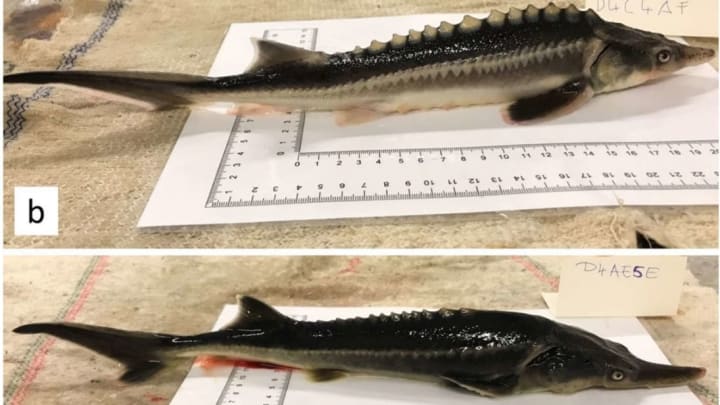The latest accidental invention from the world of science is the sturddlefish, a lab-created cross between an American paddlefish (Polyodon spathula) and a Russian sturgeon (Acipenser gueldenstaedtii).
On the surface, the parental units make an unlikely pair. For one thing, they’re not exactly neighbors—as their names indicate, the sturgeon is native to Russia and its surrounding areas, and the paddlefish is found throughout the Mississippi River Valley in the United States. Their diets differ, too; the carnivorous sturgeon hunts for crustaceans and small fish along lake and river bottoms, while the paddlefish sticks to filtering zooplankton from the water.
But they do have some things in common. As The New York Times reports, paddlefish and sturgeons are both large, slow-growing freshwater fish species with long lifespans. And they’re both considered “fossil fish,” since their lineages date back to the Mesozoic era. They’re also both critically endangered as a result of habitat loss, overfishing, and pollution.
To help bolster the dwindling populations in the wild, scientists at Hungary’s Research Institute for Fisheries and Aquaculture have been working to breed the two species in captivity. Last year, they used an asexual reproduction process called gynogenesis, which requires that sperm be present, but doesn’t use DNA from it.
Only this time, a researcher mistakenly gave paddlefish sperm to sturgeon eggs. The scientists soon welcomed hundreds of bouncing baby hybrid fish with their mother’s penchant for meat-eating and various combinations of their parents’ physical attributes. A study of the hybrid was published in the July issue of the journal Genes.

“We never wanted to play around with hybridization,” Dr. Attila Mozsár, a senior research fellow at the institute and co-author of the study, told The New York Times. “It was absolutely unintentional.”
Approximately 100 sturddlefish are still alive in the lab, but the researchers aren’t planning to breed more. If the fish, like many other hybrids, are sterile, they won’t be able to produce any caviar, which is what Russian sturgeons are mainly valued for. Furthermore, the introduction of a new hybrid into the wild could threaten existing species.
Sturddlefish, ligers, and mules aren’t the only offbeat animal hybrids out there—learn about grolar bears, wholphins, and more here.
[h/t The New York Times]
